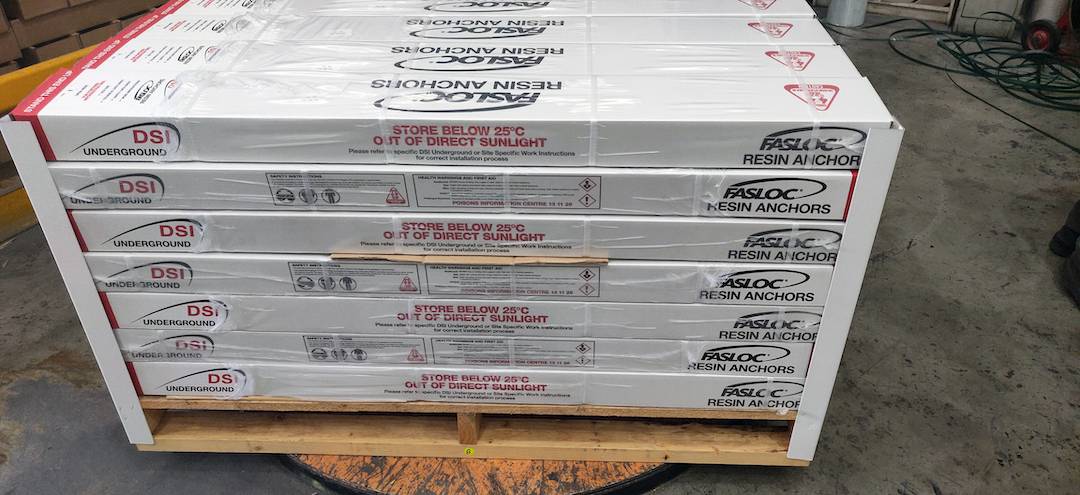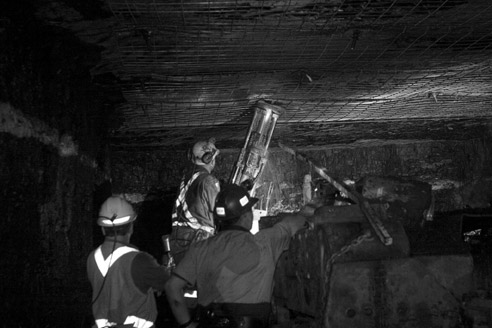Rock Bolts – Friction Bolt
Product Code FBS47
| Physical Properties | Minimum | Typical | ||
|---|---|---|---|---|
| Yield Strength | 400MPa | 137kN | 445MPa | 153kN |
| Tensile Strength | 460MPa | 158kN | 505MPa | 174kN |
| Friction Bolt Diameter | 47mm | 47mm | 47mm | 47mm |
| Hole Diameter Range | 43mm min/ 45.5mm max | 43mm min/ 45.5mm max | 43mm min/ 45.5mm max | 43mm min/ 45.5mm max |
| Mass Per Metre | 2.70kg | 2.70kg | 2.70kg | 2.70kg |
| Cross Sectional Area | 344mm2 | 344mm2 | 344mm2 | 344mm2 |
Key Features
- The DSI Friction Bolt is manufactured from high strength steel tube which has a slot along its entire length. A ring, or collar, is welded on the outer end to hold a domed plate to the rock surface.
- Micro alloyed steel provides elevated yield stress reducing the bending effect on insertion during installation.
- Friction bolts can be load tested by fitting apull ringto the bolt prior to its installation. Pull tests can then be conducted with a hollow ram hydraulic jack.
ADVANTAGES OF HIGH CAPACITY RING
- Ring design retains strength and integrity in squeezing ground conditions.
- Provides higher load capacity when point loaded.
- Load capacity matched with plate performance.
- Extended time before rehab is required.
INSTALLATION GUIDELINES
The following are items to be aware of when installing friction bolts:- Type of Ground - The nature of the ground must be evaluated. Different rock properties and ground conditions will affect the anchorage performance of friction bolts.
- Scaling - The ground should be thoroughly scaled before drilling and bolting. Periodic re-scaling may be required while drilling.
- Strength and Yield Capacity of Bolt - The mechanical properties of the bolt should be appropriate for the ground conditions, bolt length and bolting pattern. Pull tests should be performed to determine initial anchorage of the friction bolts.
- Hole Condition - The hole should be cleaned to ensure the friction bolt will insert smoothly. Variation in hole diameters and roughness(due to differing rock properties or excessively jointed ground) can yield variations in anchorage capacities.
- Hole Length - The hole should be 150mm deeper than the bolt length being used to allow for any rock fretting during installation. If holes are drilled too short, then the bolt will stick out of the hole and the plate will not make contact with the rock surface. Damage to the bolt will result if an attempt is made to drive the bolt further than the hole length will permit.
- Oversize Holes - The hole size required for the friction bolt is the most crucial aspect of the installation. The anchorage of the bolt relies on the fact that the hole is smaller than the diameter of the bolt. The larger the hole relative to the bolt diameter reduces the anchorage force.Oversized holes can be caused by using the incorrect bit size, leaving the drill running while flushing the hole, soft ground (faults, gouge, etc.) and bent drill steels.
- Undersize Holes - If the hole size is too small relative to the friction bolt size then it becomes extremely difficult to install the bolt. The bolt can be damaged i.e. kinked or bent when installed. Undersized holes are usually caused by worn bits and or incorrect bit sizes being used.
- Drive Times - For a typical 2.4m friction bolt, a jumbo should aim to drive the bolt into the hole in 15 to 20 seconds. This drive time corresponds to proper initial anchorages of the friction bolt. Faster drive times should serve as a warning that the hole size is too large or feed rate is too high, the initial anchorage of the bolt will be affected. (Current Jumbo outputs allow for drive times below 10 seconds, this has the potential to compromise the friction bolts performance) Longer drive times indicate smaller hole sizes possibly caused by bit wear.
- Bit Selection - Button bits are commonly up to 1.5mm larger than their stated size. A 43mm button bit may in reality be 44.5mm in diameter when new. DSI recommend a finished hole diameter range of 43 –45mm.
- Perpendicular Installation - Bolts should be installed as near perpendicular to the rock surface as possible. Friction bolts should be installed within +/-10 degrees of the drilled hole orientation. Angles greater than this may lead to the friction bolt being bent along its length during installation reducing its anchorage capacity and affect the weld ring integrity by point loading within the plate.
- Installation Driver Tools - Driver tools transfer percussive energy to the bolt during installation. The driver tools must have the proper profile to fit into the friction bolt without binding and causing damage to the bolt during installation. The driver tool must be inspected for wear on the driving surface. If a groove is worn on the face the dolly should be replaced. This groove will tend to pull the steel friction bolt tube away from the ring.
- Education - Proper education of mining personnel and supervisors is mandatory, education must be continuous. An informed workforce will save money in the long run.
- Monitoring - Installations must be monitored to ensure proper procedures and quality are maintained. Pull-test measurements should be routinely conducted on friction bolts to check initial anchorage values.











